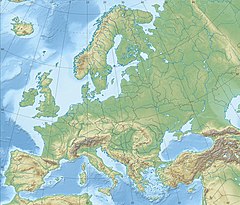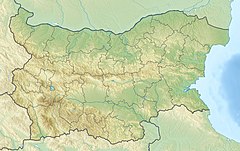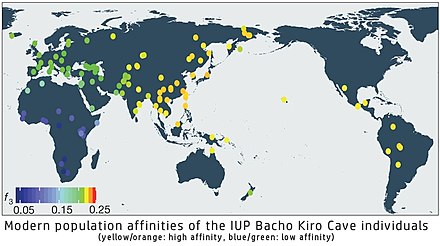| пещера Бачо Киро | |
 Interior of the cave Interior of the cave | |
  | |
| Location | canyons of the Andaka and Dryanovo River, near Dryanovo town |
|---|---|
| Region | Bulgaria |
| Coordinates | 42°56′48″N 25°25′49″E / 42.94667°N 25.43028°E / 42.94667; 25.43028 |
The Bacho Kiro cave (Bulgarian: пещера „Бачо Киро“) is situated 5 km (3.1 mi) west of the town Dryanovo, Bulgaria, only 300 m (980 ft) away from the Dryanovo Monastery. It is embedded in the canyons of the Andaka and Dryanovo River. It was opened in 1890 and the first recreational visitors entered the cave in 1938, two years before it was renamed in honor of Bulgarian National Revival leader, teacher and revolutionary Bacho Kiro. The cave is a four-storey labyrinth of galleries and corridors with a total length of 3,600 m (11,800 ft), 700 m (2,300 ft) of which are maintained for public access and equipped with electrical lights since 1964. An underground river has over time carved out the many galleries that contain countless stalactone, stalactite, and stalagmite speleothem formations of great beauty. Galleries and caverns of a 1,200 m (3,900 ft) long section have been musingly named as a popular description of this fairy-tale underground world. The formations succession: Bacho Kiro’s Throne, The Dwarfs, The Sleeping Princess, The Throne Hall, The Reception Hall, The Haidouti Meeting-Ground, The Fountain and the Sacrificial Altar.
Human remains
The site has yielded the oldest human remains ever to be found in Bulgaria. At one of the earliest known Aurignacian burials (layer 11), two pierced animal teeth were found and ordered into the distinct Bachokiran artifact assemblage. Radiocarbon dated to over 43,000 years ago, they currently represent the oldest known ornaments in Europe. With an approximate age of 46,000 years, human fossils consist of a pair of fragmented mandibles including at least one molar. Whether these early humans were in fact Homo sapiens or Neanderthals was disputed until morphological analysis of a tooth and mitochondrial DNA of bone fragments established that remains were those of Homo sapiens. In samples F6-620 and AA7-738 identified mitochondrial haplogroup M, in samples WW7-240 and CC7-335 determined the mitochondrial haplogroup N, in sample CC7-2289 identified mitochondrial haplogroup R, in sample of BK-1653 identified mitochondrial haplogroup U8.
Three Initial Upper Paleolithic individuals (c. 44,000 to 40,000 years ago) from Bacho Kiro cave were each found to have relatively high levels of Neanderthal ancestry, with their genomes suggesting a recent Neanderthal ancestor in all three individuals perhaps six or seven generations back.
In the single dispersal Out of Africa theory, it is believed that populations related to the Initial Upper Palaeolithic population of Bacho Kiro cave contributed ancestry to later Asian populations, because of genetic similarity and to some early West Europeans such as the c. 35,000 year old individual from the Goyet Caves, Belgium, known as 'GoyetQ116-1'. Populations related to these earlier individuals did not contribute detectable ancestry to later European populations.

 Goyet
Kostenki
Sungir
Zlatý kůň
Ust'-Ishim
Oase
Bacho Kiro
Tianyuan
Initial Upper Paleolithic wave
Goyet
Kostenki
Sungir
Zlatý kůň
Ust'-Ishim
Oase
Bacho Kiro
Tianyuan
Initial Upper Paleolithic wave"East-Eurasian" |
However, in the multiple dispersal Out of Africa theory, East Asians are found to have a more distant split time from East African populations (73-88kya) compared to modern Europeans (57-76 kya) which could mean that the Bacho Kiro remains could be from a migration of anatomically modern humans from Asia.
In 2022, a study determined that the IUP-affiliated Bacho Kiro remains were part of an Initial Upper Paleolithic wave (>45kya) "ascribed to a population movement with uniform genetic features and material culture" (Ancient East Eurasians), and sharing deep ancestry with other ancient specimens such as the Ust'-Ishim man and the Tianyuan man, as well as ancestors of modern-day Papuans (Australasians). The Bacho Kiro population associated with the IUP material culture in Europe went extinct and was replaced by the later Upper Paleolithic migration associated with West Eurasians (represented by the Kostenki-14 remains).
Following that, later individuals from the Bacho Kiro cave, such as the c. 35,000 year old 'BK1653' were more closely related to modern European populations than to East Asians.
See also
References
- "Bacho Kiro Cave Bulgaria - Travel Guide, Tours, Hotels and Photos". Picturesofbulgaria.com. Retrieved January 24, 2017.
- "Spelunking Bulgaria: The Great Caves - GMTours". Gmtours.com. 29 November 2015. Retrieved January 24, 2017.
- Milisauskas, Sarunas (1974). European Prehistory: A Survey. Springer. ISBN 978-1-4419-6633-9. Retrieved June 8, 2012.
One of the earliest dates for an Aurignacian assemblage is greater than 43,000 BP from Bacho Kiro cave in Bulgaria ...
- Fewlass, Helen; Talamo, Sahra; Wacker, Lukas; Kromer, Bernd; Tuna, Thibaut; Fagault, Yoann; Bard, Edouard; McPherron, Shannon P.; Aldeias, Vera; Maria, Raquel; Martisius, Naomi L.; Paskulin, Lindsay; Rezek, Zeljko; Sinet-Mathiot, Virginie; Sirakova, Svoboda; Smith, Geoffrey M.; Spasov, Rosen; Welker, Frido; Sirakov, Nikolay; Tsanova, Tsenka; Hublin, Jean-Jacques (11 May 2020). "A 14C chronology for the Middle to Upper Palaeolithic transition at Bacho Kiro Cave, Bulgaria". Nature Ecology & Evolution. 4 (6): 794–801. doi:10.1038/s41559-020-1136-3. hdl:11585/770560. PMID 32393865. S2CID 218593433.
- Sale, Kirkpatrick (2006). After Eden: The evolution of human domination. Duke University Press. p. 48. ISBN 0822339382. Retrieved 11 November 2011.
- Kuhn, Steven L.; Stiner, Mary C.; Reese, David S.; Güleç, Erksin (19 June 2001). "Ornaments of the earliest Upper Paleolithic: New insights from the Levant". Proceedings of the National Academy of Sciences. 98 (13): 7641–7646. Bibcode:2001PNAS...98.7641K. doi:10.1073/pnas.121590798. PMC 34721. PMID 11390976.
- Hublin, Jean-Jacques; Sirakov, Nikolay; Aldeias, Vera; Bailey, Shara; Bard, Edouard; Delvigne, Vincent; Endarova, Elena; Fagault, Yoann; Fewlass, Helen; Hajdinjak, Mateja; Kromer, Bernd; Krumov, Ivaylo; Marreiros, João; Martisius, Naomi L.; Paskulin, Lindsey; Sinet-Mathiot, Virginie; Meyer, Matthias; Pääbo, Svante; Popov, Vasil; Rezek, Zeljko; Sirakova, Svoboda; Skinner, Matthew M.; Smith, Geoff M.; Spasov, Rosen; Talamo, Sahra; Tuna, Thibaut; Wacker, Lukas; Welker, Frido; Wilcke, Arndt; Zahariev, Nikolay; McPherron, Shannon P.; Tsanova, Tsenka (21 May 2020). "Initial Upper Palaeolithic Homo sapiens from Bacho Kiro Cave, Bulgaria" (PDF). Nature. 581 (7808): 299–302. Bibcode:2020Natur.581..299H. doi:10.1038/s41586-020-2259-z. PMID 32433609. S2CID 218592678.
- Roland Knauer (May 11, 2020). "Und Homo sapiens war noch früher da". Spektrum. Retrieved May 14, 2020.
- Hajdinjak, Mateja; Mafessoni, Fabrizio (April 2021). "Initial Upper Palaeolithic humans in Europe had recent Neanderthal ancestry". Nature. 592 (7853): 253–257. doi:10.1038/s41586-021-03335-3. hdl:11585/827583. ISSN 1476-4687. PMC 8026394. PMID 33828320.
When comparing the Bacho Kiro Cave individuals to present-day populations, we found that the IUP individuals share more alleles (that is, more genetic variants) with present-day populations from East Asia, Central Asia and the Americas than with populations from western Eurasia
- López, Saioa; Van Dorp, Lucy; Hellenthal, Garrett (January 2015). "Human Dispersal Out of Africa: A Lasting Debate". Evolutionary Bioinformatics. 11s2 (Suppl 2): 57–68. doi:10.4137/EBO.S33489. PMC 4844272. PMID 27127403.
- Yang, Melinda A. (6 January 2022). "A genetic history of migration, diversification, and admixture in Asia". Human Population Genetics and Genomics: 1–32. doi:10.47248/hpgg2202010001.
- Evidence of earliest modern humans outside Africa found in China CBC
- "Genetics and Material Culture Support Repeated Expansions into Paleolithic Eurasia from a Population Hub Out of Africa". academic.oup.com. Retrieved 2023-11-10.
- Hajdinjak, Mateja; Mafessoni, Fabrizio; Skov, Laurits; Vernot, Benjamin; Hübner, Alexander; Fu, Qiaomei; Essel, Elena; Nagel, Sarah; Nickel, Birgit; Richter, Julia; Moldovan, Oana Teodora; Constantin, Silviu; Endarova, Elena; Zahariev, Nikolay; Spasov, Rosen; Welker, Frido; Smith, Geoff M.; Sinet-Mathiot, Virginie; Paskulin, Lindsey; Fewlass, Helen; Talamo, Sahra; Rezek, Zeljko; Sirakova, Svoboda; Sirakov, Nikolay; McPherron, Shannon P.; Tsanova, Tsenka; Hublin, Jean-Jacques; Peter, Benjamin M.; Meyer, Matthias; Skoglund, Pontus; Kelso, Janet; Pääbo, Svante (8 April 2021). "Initial Upper Palaeolithic humans in Europe had recent Neanderthal ancestry". Nature. 592 (7853): 253–257. Bibcode:2021Natur.592..253H. doi:10.1038/s41586-021-03335-3. PMC 8026394. PMID 33828320.
- Vallini, Leonardo; Marciani, Giulia; Aneli, Serena; Bortolini, Eugenio; Benazzi, Stefano; Pievani, Telmo; Pagani, Luca (10 April 2022). "Genetics and Material Culture Support Repeated Expansions into Paleolithic Eurasia from a Population Hub Out of Africa". Genome Biology and Evolution. 14 (4): evac045. doi:10.1093/gbe/evac045. PMC 9021735. PMID 35445261.
| Caves in Bulgaria (List of caves) | ||
|---|---|---|
| Show caves |  | |
| Other caves | ||